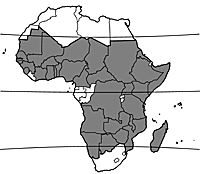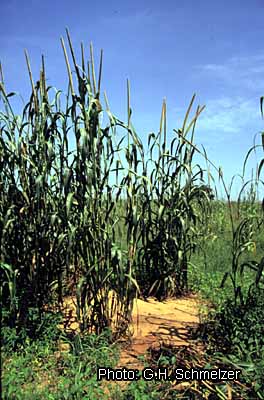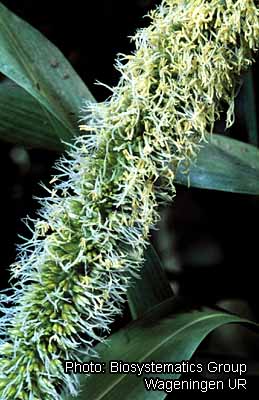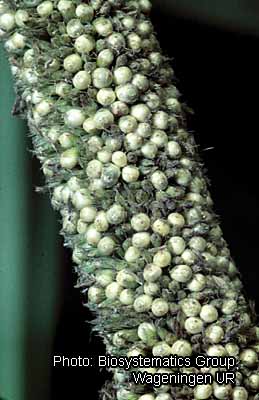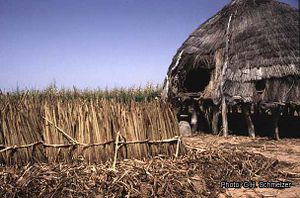Pennisetum glaucum (PROTA)
Introduction |
| General importance | |
| Geographic coverage Africa | |
| Geographic coverage World | |
| Cereal / pulse | |
| Vegetable | |
| Medicinal | |
| Forage / feed | |
| Fibre | |
| Food security | |
Pennisetum glaucum (L.) R.Br.
- Protologue: Prodr.: 195 (1810).
- Family: Poaceae (Gramineae)
- Chromosome number: 2n = 14
Synonyms
- Pennisetum spicatum (L.) Körn. (1885),
- Pennisetum americanum (L.) Leeke (1907),
- Pennisetum typhoides (Burm.f.) Stapf & C.E.Hubb. (1933).
Vernacular names
- Pearl millet, bulrush millet, cattail millet (En).
- Mil, mil à chandelle, mil pénicillaire, petit mil (Fr).
- Milho zaburro, milho preto, milheto, massango liso (Po).
- Mwele (Sw).
Origin and geographic distribution
Pearl millet was domesticated in the Sahel 4000–5000 years ago from Pennisetum violaceum (Lam.) Rich. It spread to East Africa and from there to southern Africa, and, about 3000 years ago, to the Indian subcontinent. It reached tropical America in the 18th century and the United States in the 19th century. Pearl millet is commonly grown as a grain crop in the semi-arid regions of West Africa and the driest parts of East and southern Africa and the Indian subcontinent. It is also grown as a fodder crop, e.g. in Brazil, the United States, South Africa, and Australia.
Uses
Pearl millet is the staple food for over 100 million people in parts of tropical Africa and India. Decorticated and pounded into flour it is consumed as a stiff porridge (‘tô’) or gruel in Africa, or as flat unleavened bread (‘chapatti’) in India. In Africa there are various other preparations such as couscous, rice-like products, snacks of blends with pulses, and fermented and non-fermented beverages. In several Indian preparations parched seeds are used. The stems are widely applied for fencing, thatching and building, as fuel and as a poor-quality fodder. Split stems are used for basketry. A dye for leather and wood is obtained from red- and purple-flowered types. In African traditional medicine the grain has been applied to treat chest disorders, leprosy, blennorrhoea and poisonings, and the ground grain as an anthelmintic for children. A root decoction is drunk to treat jaundice; the vapour of inflorescence extracts is inhaled for respiratory diseases in children. In some areas the grains are used in rituals. Outside Africa and India pearl millet is mostly grown as a green fodder crop for silage, hay making and grazing. Following the discovery that pearl millet can suppress root-lesion nematodes (Pratylenchus penetrans) it is increasingly being used as an alternative to soil fumigation in tobacco and potato cropping in Canada.
Production and international trade
Production statistics often combine data on all millet species. Estimates based on total millet production (FAO statistics) and relative importance of pearl millet in different countries indicate an annual grain production of about 18 million t from a planted area of 26.5 million ha mostly in the dry regions of Africa (60% of area and 58% of production) and the Indian subcontinent (38% of area and 41% of production). Production statistics over the past 10 years show a 20% increase in area planted in Africa, with a 12% increase in yield. Most of the area increase is in Burkina Faso, Chad, Mali, Niger and Nigeria, but yield levels increased only in the latter two countries. During the same period, the area planted to pearl millet in India declined by 16%, but yield levels increased by 30%. Negligible quantities are traded internationally.
Properties
Whole dried grain of pearl millet contains per 100 g edible portion: water 12.0 g, energy 1428 kJ (341 kcal), protein 10.4 g, fat 4.0 g, carbohydrate 71.6 g, fibre 1.9 g, Ca 22 mg, P 286 mg, Fe 20.7 mg, β-carotene traces, thiamin 0.30 mg, riboflavin 0.22 mg, niacin 1.7 mg and ascorbic acid 3 mg (Leung, Busson & Jardin, 1968). The content of essential amino acids per 100 g food is: tryptophan 189 mg, lysine 332 mg, methionine 239 mg, phenylalanine 467 mg, threonine 374 mg, valine 535 mg, leucine 927 mg and isoleucine 397 mg (FAO, 1970). From a nutritional viewpoint pearl millet is better than maize and sorghum. Compared to that of other millets, the protein of pearl millet is rich in tryptophan.
Description
- Robust annual grass up to 4 m tall, with basal and nodal tillering; root system extremely profuse, sometimes the nodes at ground level produce thick, strong prop roots; stem slender, 1–3 cm in diameter, solid, often densely villous below the panicle, nodes prominent.
- Leaves alternate, simple; leaf sheath often hairy; ligule short, membranous, with a fringe of hairs; blade linear to linear-lanceolate, up to 1.5 m × 8 cm, often pubescent, margins minutely toothed, somewhat rough.
- Inflorescence a cylindrical, contracted, stiff and compact panicle, suggesting a spike, up to 200 cm long; rachis cylindrical, bearing densely packed clusters of 1–5(–9) spikelets, subtended by a tuft (involucre) of up to 90 bristles about as long as spikelets, but in some cultivars with a few stiff bristles up to 2 cm long.
- Spikelets obovate, 3–7 mm long, usually 2-flowered; glumes 2, lower one c. 1 mm long, upper one c. 2.5 mm; lower floret male or sterile, upper one bisexual; lemma ovate, pubescent on margins; palea almost as long as lemma; lodicules absent; stamens 3, anthers 2–5 mm long, tipped with brush-like bristles; ovary superior, obovoid, smooth, with 2 hairy stigmas, connate at the base.
- Fruit a free-threshing caryopsis (grain), globose to cylindrical or conical, 2.5–6.5 mm long, variously coloured, from white, pearl-coloured or yellow to grey-blue or brown, occasionally purple, hilum marked by a distinct black dot at maturity.
Other botanical information
Pennisetum comprises about 80 species and occurs throughout the tropics. Pearl millet is not closely related to most other Pennisetum species, although it hybridizes easily with elephant grass (Pennisetum purpureum Schumach., a tetraploid with 2n = 28). Pennisetum glaucum belongs to a complex of 3 taxa that hybridize freely and are sometimes considered as subspecies of Pennisetum glaucum. However, as long as the complicated taxonomy of pearl millet has not been fully cleared up, it is preferable to keep these taxa separate:
- Pennisetum glaucum: cultivated types, with persistent, stiped involucres; the dense inflorescences and non-shattering habit are conspicuous.
- Pennisetum sieberianum (Schltdl.) Stapf & C.E.Hubb. (synonyms: Pennisetum stenostachyum (A.Braun & Bouché) Stapf & C.E.Hubb., Pennisetum dalzielii Stapf & C.E.Hubb., Pennisetum americanum (L.) Leeke subsp. stenostachyum (A.Braun & Bouché) Brunken): weedy types, resulting from introgression between wild Pennisetum violaceum and cultivated Pennisetum glaucum and ranging in morphology between wild and cultivated types; in the latter case they are termed ‘shibras’ and they look much like Pennisetum glaucum cultivars, but differ in having deciduous shortly stiped involucres, and spikelets which shatter before harvest; bristles numerous, longer than spikelets; widespread in the Sahel and also found, though less frequently, in East and southern Africa.
- Pennisetum violaceum (Lam.) Rich. ex Pers. (synonyms: Pennisetum fallax (Fig. & De Not.) Stapf & C.E.Hubb., Pennisetum americanum (L.) Leeke subsp. monodii (Maire) Brunken): wild, variable type, with deciduous sessile involucres which always contain a single spikelet; bristles numerous, longer than spikelets; distributed from the West African Sahel region to Eritrea in very dry locations, independent of farming; sometimes harvested as a wild cereal in times of scarcity.
Although many intermediate cultivars occur, 4 cultivar groups (originally described as races) can be distinguished in cultivated Pennisetum glaucum, based mainly on grain shape and partly on distribution:
- Typhoides Group; grain obovoid, circular in cross-section, 2.5–5.5 mm × 1. 5–3 mm × 1–2.5 mm, inflorescence cylindrical or ellipsoidal, usually less than 0.5 m long; it is the most primitive, the most variable and most widely distributed group, occurring all over the pearl millet range in Africa and India, and is probably ancestral for the other groups.
- Globosum Group: grain globose, more than 2.5 mm in diameter, inflorescence cylindrical, often longer than 1 m; most common in the Sahel region west of Nigeria.
- Leonis Group: grain oblanceolate in outline, circular in cross-section, 4–6.5 mm × 2–2.5 mm × 2–2.5 mm, apex acute, inflorescence cylindrical; this is the smallest group and is grown in Mauritania, Senegal and Sierra Leone.
- Nigritarum Group; grain obovoid but angular in cross-section, 3–5 mm × 1.5–2.5 mm × 1.5–2 mm, inflorescence cylindrical; most common in semi-arid regions from Nigeria to Sudan.
Agronomically two main groups of cultivars are recognized in West Africa, based on growth duration : short-duration Gero (or Souna) cultivars and long-duration Maiwa (or Sanio) cultivars. Gero cultivars are less photoperiod-sensitive, are more widely grown and exhibit more genetic diversity than Maiwa cultivars, in which flowering date is strongly controlled by daylength. Maiwa types are grown in regions where the rainy season is longer and where sorghum is the major cereal, but on poorer, more drought-prone soils. Certain Maiwa millets are transplanted from nurseries into the field and are known as Dauro millet.
The improved cultivars and dwarf single-cross hybrids grown in India are stronger tillering, early (80 days) to very early (65 days) maturing and less photoperiod-sensitive than African cultivars.
Growth and development
Pearl millet cultivars vary in time to maturity from 55–280 days, but mostly from 75–180 days. Time to flower initiation is the main factor determining the life cycle of a cultivar. Floral initiation is weakly to strongly controlled by photoperiod, with short days accelerating flower initiation. Photoperiod response allows crop cycle length to be adjusted by time of planting, needed when rains begin late, to ensure that flowering and grain production occur at the same optimum time each year for a specific latitude. In short-duration, photoperiod-insensitive cultivars the developmental stages (from germination to flower initiation, to flowering and to maturity) are of approximately equal duration.
Field establishment of pearl millet is affected by its relatively small seed size, especially in crusting soils. Other factors that influence stand establishment include high soil surface temperatures at emergence (as high as 50–55°C), sand storms and early season moisture stress. During early development the roots grow more than the above-ground parts. Pearl millet produces an extensive and dense root system, which may reach a depth of 1.2–1.6 m, exceptionally 3.5 m. Basal tillering occurs 2–6 weeks after sowing, and when planted in widely spaced pockets up to 40 tillers may be produced, especially on long-season cultivars. Secondary tillering from the upper nodes of stems is a common response to drought, or to damage to the stem or inflorescence. These aerial tillers produce 2–3 leaves and a small inflorescence within 10–20 days; they may contribute 15% and occasionally up to 50% of grain yield. It takes 15–20 days from inflorescence differentiation to flowering. Pearl millet has a protogynous breeding system, which encourages but does not enforce cross-pollination; 10% or more inbreeding may occur, depending on overlap in flowering between florets within an inflorescence and among tillers. Pearl millet cultivars are therefore heterogeneous and heterozygous random mating populations, which exhibit substantial inbreeding depression. Heavy rainfall, low temperature and moisture stress reduce seed set. The grain-filling period normally takes 22–25 days. The harvest index of landraces is low (0.15–0.20), attaining 0.35 in improved cultivars, and up to 0.45 in dwarf hybrids.
Pearl millet is characterized by the C4 photosynthetic pathway. Vesicular-arbuscular mycorrhizae (e.g. Gigaspora and Glomus spp.) and nitrogen-fixing bacteria (e.g. Azospirillium spp.) are commonly found associated with pearl millet roots, which may assist with the uptake of water, N and P.
Ecology
In West Africa, from the oases of the Sahara desert (under irrigation) to the northern Sahel (characterized by 250 mm annual rainfall), pearl millet cultivars are grown that are photoperiod insensitive and mature in 55–65 days. In the 250–400 mm rainfall zone, where very high temperatures are common, especially at planting time, it is the dominant cereal. The optimum temperature for germination of pearl millet seeds is 33–35°C; no germination occurs below 12°C. The optimum temperature for tiller production and development is 21–24°C, and for spikelet initiation and development about 25°C. Extreme high temperatures before anthesis reduce pollen viability, panicle size and spikelet density, thus reducing yield. Pearl millet is tolerant of various soil conditions, especially of light and acid soils. Its large and dense root system allows it to grow on soils with a low nutrient status. Pearl millet does not tolerate waterlogging. Once established, the crop is fairly tolerant of salinity.
Propagation and planting
Propagation of pearl millet is by seed, usually sown directly in the field. Transplanting is carried out on a very limited scale in India and West Africa (Dauro millet). The 1000-seed weight is 2.5–16 g. In Africa short-duration cultivars are sown early, after the first 20 mm rain of the season and land preparation is limited to a light hoeing. Land preparation for long-duration cultivars, which are sown later, is done more thoroughly. Pearl millet is usually sown directly in pockets (hills) in rows at plant distances of 45 cm × 45 cm to 200 cm × 200 cm depending on the cropping system (intercrop or sole crop). The pockets are opened with a hoe or a stick, a pinch of seeds is thrown in, and the hole is covered by soil using the foot. At the first weeding the crop is thinned to 2 or 3 plants per pocket. Farmers tend to adjust plant density based on average rainfall and soil fertility; it generally ranges from 20,000–50,000 plants per ha in pure stands. Seed rates vary accordingly from 2–5 kg per ha. Pearl millet is often intercropped with one to several crops, including cowpea, sorghum and groundnut.
Management
Pearl millet frequently needs 2–3 weedings, which are done mostly by hand. With short-duration cultivars in Africa, weeding coincides with land preparation and planting of later crops. Manual weeding places severe demands on available labour and limits the area that can be managed properly. In a few regions animal-drawn implements are used for weeding. Pearl millet is highly responsive to increased soil fertility, but under traditional rainfed farming conditions the application of manure and chemical fertilizers is limited. Because of the depleted fertility status of most pearl millet soils some phosphorus and potassium is needed for an optimal response to nitrogenous fertilizers. As fertilizers increase water use of the crop, plant populations and average seasonal water availability also need to be considered when making fertilizer recommendations. A pearl millet crop yielding about 3.1 t grain per ha in the West African savanna was recorded as removing 132 kg N, 28 kg P, 65 kg K and 31 kg Ca per ha from the soil.
Diseases and pests
Green ear caused by downy mildew (Sclerospora graminicola), grain smut (Tolyposporium penicillariae), rust (Puccinia substriata var. penicillariae) and ergot (Claviceps fusiformis) are important diseases of pearl millet, both in Africa and in Asia. Sources of resistance against all four have been identified and are being incorporated into new cultivars, except for resistance to ergot which is polygenic and recessively inherited. Birds are the major pest in pearl millet, especially Quelea spp. Bird scaring for several weeks before the harvest is essential. Farmers in West Africa often do not harvest a larger area than they can protect from birds. Cultivars with long, hard bristles are less vulnerable than those without. Stem borer (Coniesta ignefusalis), millet head miner (Heliocheilus albipunctella) and millet midge (Geromyia penniseti) are locally important. Other pests are white grubs, grasshoppers, locusts, and various Lepidoptera. Pearl millet is sometimes seriously attacked by adapted strains of the root parasite Striga hermonthica (Delile) Benth. in West Africa.
Harvesting
Pearl millet is harvested by hand, either by picking the panicles or by harvesting whole plants. In cultivars where tillers ripen unevenly, several pickings are required. Cultivars with long panicles are favoured for ease of harvest, bundling and transport.
Yield
Grain yields range from 250 kg/ha in the driest areas to 500–1500 kg/ha in the main production areas. Average yields in Africa and India are about 670 and 790 kg/ha, respectively. Under optimal conditions hybrids may reach grain yields of 5 t per ha in 85 days and yields of 8 t per ha have even been obtained. In landraces the above-ground dry matter yield may be 3–10 t/ha. In hybrids bred specifically for forage dry matter yields in a season range from 10–20 t/ha.
Handling after harvest
A harvested pearl millet crop is dried in the sun for a few days. In Africa whole panicles are commonly stored in elevated granaries, built of mud or plant materials and covered with thatch. Sometimes they are stored in pits. Ash or neem (Azadirachta indica A.Juss.) leaves may be put in layers to reduce insect attack. Threshing is normally done manually when grain is needed. If dry and protected from insects, seed can be stored adequately at room temperature for several years. Pearl millet flour, unless dry-milled and well-packed, has poor storage quality because of rancidity due to the high oil content.
Genetic resources
Landraces of pearl millet have evolved over thousands of years through natural and human selection. Selection at different latitudes and in different agro-climatic zones for crop duration, yield, adaptability to nutrient-poor soils, resistance to drought and diseases, and grain type has resulted in local cultivars with a large range of morphological diversity and photoperiod sensitivity. Continual introgression with wild and weedy relatives in West Africa has further contributed to the crop’s genetic diversity. Genetic variation is conserved and evaluated at the Coastal Plains Experiment Station, Tifton (Georgia, United States) and the International Crops Research Institute for the Semi-Arid Tropics (ICRISAT) in Hyderabad (India), where the world collection of over 24,000 entries is housed. The International Plant Genetic Resources Institute (IPGRI) supports a programme, started in Burkina Faso, to improve the description and evaluation of material at the time and location of collection. One particular germplasm source, the ‘Iniadi’ cultivar from northern Togo and Ghana, has had a profound effect on pearl millet breeding. Selections from it have been successful as cultivars in northern India, Namibia and Botswana, and it has been extensively used in all breeding programmes.
Breeding
Both improved open-pollinated types and hybrids have been developed in pearl millet ; cytoplasmic male sterility is available for the commercial production of hybrid seed. Cultivar breeding of pearl millet started in Africa in the 1950s and traditional cultivars are still widely used. Breeding work by the Indian Council of Agricultural Research and ICRISAT has been most successful in developing cultivars that were rapidly adopted by farmers. The discovery of cytoplasmic male sterility in 1958 in the forage breeding programme at Tifton (Georgia, United States) led to the production of early-maturing, semi-dwarf grain hybrids in India, which covered 3 million ha by 1970. Despite the occurrence of disease epidemics, some 50% of the Indian pearl millet crop on family farms now consists of hybrids and improved cultivars, and yields have increased by 40% since 1965. Early breeding work in West Africa by the Institut de Recherches Agronomiques Tropicales et de Cultures Vivrières (IRAT) and the East African Agriculture and Forestry Research Organization (EAAFRO) produced improved local cultivars, but adoption was negligible. Since the early 1980s ICRISAT, working with a broader germplasm base and in conjunction with national agricultural research programmes in West, East and southern Africa, has produced better cultivars. In 8 countries in West Africa 24 cultivars (11 for the Sahel zone and 13 for the Sudan Zone) have been released and in East and southern Africa 19 new cultivars are available for 8 countries with adoption rates of up to 50% (Namibia, Zimbabwe). Work at ICRISAT is focused on the identification of stable stress tolerance, wide adaptability and high yield potential. Sources of tolerance of the major diseases have been identified and are being incorporated into new cultivars. Two further cytoplasmic male sterility systems (A4 and A5), which have superior attributes both for hybrid breeding and seed production, have been discovered. These allow access to different heterotic patterns and more rapid development of new hybrids, particularly topcross hybrids which are most suited to the higher disease pressures in Africa. On average, single-cross hybrids (male-sterile × inbred restorer) give about 20% more grain yield than open-pollinated cultivars of similar maturity. Topcross hybrids (male-sterile × open-pollinated cultivars) benefit from the adaptability and durable disease resistance of the open-pollinated type, and give 10–15% more yield. The pearl millet genome has now been well mapped, and marker-assisted selection is being used to improve downy mildew and rust resistance. Transgenic pearl millet plants with various marker genes have been obtained using particle bombardment.
Forage breeding work, mainly in the United States, Australia, Brazil and southern Africa, has also produced pearl millet hybrids. Interspecific hybrids between pearl millet and elephant grass (Pennisetum purpureum) are available; these are vigorous, variable, triploid and sterile, but selections are easily vegetatively propagated and used as a persistent perennial forage by small farmers in South-East Asia, East and southern Africa and South America. In the United States dwarf plant stature and synchronous maturity of tillers, in addition to earliness and tolerance of diseases have been successfully incorporated into pearl millet to convert it to a new feed grain crop suitable for mechanical cultivation. Commercial production of grain pearl millet for poultry feed has commenced in Georgia (United States).
Prospects
Pearl millet has great potential because it has one of the highest rates of dry matter gain among the C4-cycle cereals, a very flexible breeding system and a large amount of genetic variability in the primary gene pool yet to be used. The results of pearl millet breeding work in India, where gains from breeding have been 1–2% per year over the last 35 years, demonstrate what can be achieved in Africa. Half of the millet area in India is now planted to improved cultivars, including hybrids. Proven breeding techniques and wider use of genetic resources will continue to produce better cultivars.
In Africa small and seasonably variable grain markets, lack of credit and bulk grain storage have constrained farmers from making the monetary investments which will increase production. However, the growing urban demand for pearl millet flour, and food products like couscous allow farmer cooperatives in Niger, Mali and Senegal to make contracts before planting directly with urban grain processors, for the supply of grain meeting given standards, including grain type and colour, milling quality, flavour and freedom from impurities. In Senegal the cultivar is also specified. This enables subsistence farmers to benefit from seed of improved cultivars, and from purchased inputs such as fertilizer. Better cultivars, produced by certified seed farmers, are being marketed in Namibia, Nigeria and Senegal. Many production technologies have been researched and tested both for family farmers and larger-scale pearl millet cultivation, including improved cultivars, better crop management, soil improvement and moisture conservation techniques for the major pearl millet producing regions in Africa. If reliable grain markets are established, pearl millet production in Africa can follow the example of India, and increase substantially on existing land.
Major references
- Anand Kumar, K. & Andrews, D.J., 1993. Genetics of qualitative traits in pearl millet: a review. Crop Science 33: 1–20.
- Andrews, D.J. & Bramel-Cox, P., 1993. Breeding cultivars for sustainable crop production in low input dryland agriculture in the tropics. In: Buxton, D.R., Shibles, R., Forsberg, R.A., Blad, B.L., Asay, K.H., Paulsen, G.M. & Wilson, R.F. (Editors). International Crop Science 1. Crop Science Society of America, Madison, Wisconsin, United States. pp. 211–222.
- Andrews, D.J. & Kumar, K.A., 1992. Pearl millet for food, feed and forage. Advances in Agronomy 48: 89–139.
- Bidinger, F.R. & Hash, C.T., 2004. Pearl millet. In: Nguyen, H.T. & Blum, A. (Editors). Physiology and biotechnology integration for plant breeding. Marcel Dekker, New York, United States. pp. 225–270.
- Brunken, J., de Wet, J.M.J. & Harlan, J.R., 1977. The morphology and domestication of pearl millet. Economic Botany 31: 163–174.
- Dendy, D.A.V. (Editor), 1995. Sorghum and millets: chemistry and technology. American Association of Cereal Chemists, St. Paul, Minnesota, United States. 406 pp.
- Khairwal, I.S., Rai, K.N., Andrews, D.J. & Harinarayana, G., 1999. Pearl millet breeding. Science Publishers, Enfield, New Hampshire, United States. 511 pp.
- Oyen, L.P.A. & Andrews, D.J., 1996. Pennisetum glaucum (L.) R. Br. In: Grubben, G.J.H. & Partohardjono, S. (Editors). Plant Resources of South-East Asia No 10. Cereals. Backhuys Publishers, Leiden, Netherlands. pp. 119–123.
- Pearson, C.J. (Editor), 1985. Pearl millet, special issue. Field Crops Research 11(2–3): 111–290.
- Renard, C. & Anand Kumar, K., 2001. Pearl millet. In: Raemaekers, R.H. (Editor). Crop Production in tropical Africa. Directorate General of International Co-operation (DGIC), Ministry of Foreign Affairs, External Trade and International Co-operation, Brussels, Belgium. pp. 46–58.
Other references
- Andrews, D.J. & Anand Kumar, K., 1996. Use of the West African pearl millet cultivar Iniadi in cultivar development. Plant Genetic Resources Newsletter 105: 15–22.
- Bationo, A., Christianson, C.B., Baethgen, W.E. & Mokwunye, A.U., 1992. A farm-level evaluation of nitrogen and phosphorus fertilizer use and planting density for pearl millet production in Niger. Fertilizer Research 31: 175–184.
- Bezançon, G., Renno, J.-F. & Anand Kumar, K., 1997. Le mil. In: Charrier, A., Jacquot, M., Hamon, S. & Nicolas, D. (Editors). L’amélioration des plantes tropicales. Centre de coopération internationale en recherche agronomique pour le développement (CIRAD) & Institut français de recherche scientifique pour le développement en coopération (ORSTOM), Montpellier, France. pp. 457–482.
- Bonamigo, L.A., 1999. Pearl millet crop in Brazil: implementation and development in the Cerrado Savannahs. In: Farias Neto, A.L., Amabile, R.F., Martins Netto, D.A., Yamashita, T. & Gocho, H. (Editors). International pearl millet workshop, Planaltina, Brazil, June 9–10, 1999. EMBRAPA, Planaltina, Brazil. pp. 31–66.
- Burkill, H.M., 1994. The useful plants of West Tropical Africa. 2nd Edition. Volume 2, Families E–I. Royal Botanic Gardens, Kew, Richmond, United Kingdom. 636 pp.
- Clayton, W.D., 1989. Gramineae (Paniceae, Isachneae and Arundinelleae). In: Launert, E. & Pope, G.V. (Editors). Flora Zambesiaca. Volume 10, part 3. Flora Zambesiaca Managing Committee, London, United Kingdom. 231 pp.
- Clayton, W.D. & Renvoize, S.A., 1982. Gramineae (part 3). In: Polhill, R.M. (Editor). Flora of Tropical East Africa. A.A. Balkema, Rotterdam, Netherlands. pp. 451–898.
- de Wet, J.M.J., 1995. Pearl millet. In: Smartt, J. & Simmonds, N.W. (Editors). Evolution of crop plants. 2nd Edition. Longman Scientific & Technical, Harlow, United Kingdom. pp. 156–159.
- FAO, 1970. Amino-acid content of foods and biological data on proteins. FAO Nutrition Studies No 24, Rome, Italy. 285 pp.
- Hash, C.T., Schaffert, R.E. & Peacock, J.M., 2002. Prospects for using conventional techniques and molecular biological tools to enhance performance of ‘orphan’ crop plants on soils low in available phosphorus. Plant and Soil 245: 135–146.
- Jagdale, G.B., Ball-Coelho, B., Potter, J., Brandle, J. & Roy, R.C., 2000. Rotation crop effects on Pratylenchus penetrans and subsequent crop yields. Canadian Journal of Plant Science 80: 543–549.
- Leung, W.-T.W., Busson, F. & Jardin, C., 1968. Food composition table for use in Africa. FAO, Rome, Italy. 306 pp.
- McDonough, C.M., Rooney, L.W. & Serna-Saldivar, S.O., 2000. The millets. In: Kulp, K. & Ponte, J.G. (Editors). Handbook of cereal science and technology. 2nd Edition. Marcel Dekker, New York, United States. pp. 177–201.
- Monyo, E.S., 2002. Pearl millet cultivars released in the SADC region. ICRISAT, Bulawayo, Zimbabwe. 35 pp.
- National Research Council, 1996. Lost crops of Africa. Volume 1: grains. National Academy Press, Washington D.C., United States. 383 pp.
- O’Kennedy, M.M., Burger, J.T. & Botha, F.C., 2004. Pearl millet transformation system using the positive selectable marker gene phosphomannose isomerase. Plant Cell Reports 22(9): 684–690.
- Rachie, K.O. & Majmudar, J.V., 1980. Pearl millet. Pennsylvania State University Press, University Park, United States. 305 pp.
- Rai, K.N., Anand Kumar, K., Andrews, D.J. & Rao, A.S., 2001. Commercial viability of alternative cytoplasmic-nuclear male-sterility systems in pearl millet. Euphytica 121: 107–114.
- Stoop, W.A., 1986. Agronomic management of cereal/cowpea cropping systems for major toposequence land types in the West African savanna. Field Crops Research 14: 301–319.
- Wilson, J.P., 2000. Pearl millet diseases. A compilation of information on the known pathogens of pearl millet Pennisetum glaucum (L.) R. Br. Agriculture Handbook No 716. United States Department of Agriculture, Agricultural Research Service, Washington D.C., United States. 50 pp.
Sources of illustration
- Oyen, L.P.A. & Andrews, D.J., 1996. Pennisetum glaucum (L.) R. Br. In: Grubben, G.J.H. & Partohardjono, S. (Editors). Plant Resources of South-East Asia No 10. Cereals. Backhuys Publishers, Leiden, Netherlands. pp. 119–123.
Author(s)
- D.J. Andrews, Department of Agronomy and Horticulture, University of Nebraska, P.O. Box 830817, Lincoln, NE 68583-0817, United States
- K.A. Kumar, Agriculture Environmental Renewal Canada Inc., 711 Schafer Road, P.O. Box 186, Delhi, Ontario N4B 2W9, Canada
Correct citation of this article
Andrews, D.J. & Kumar, K.A., 2006. Pennisetum glaucum (L.) R.Br. In: Brink, M. & Belay, G. (Editors). PROTA (Plant Resources of Tropical Africa / Ressources végétales de l’Afrique tropicale), Wageningen, Netherlands. Accessed 18 December 2024.
- See the Prota4U database.

